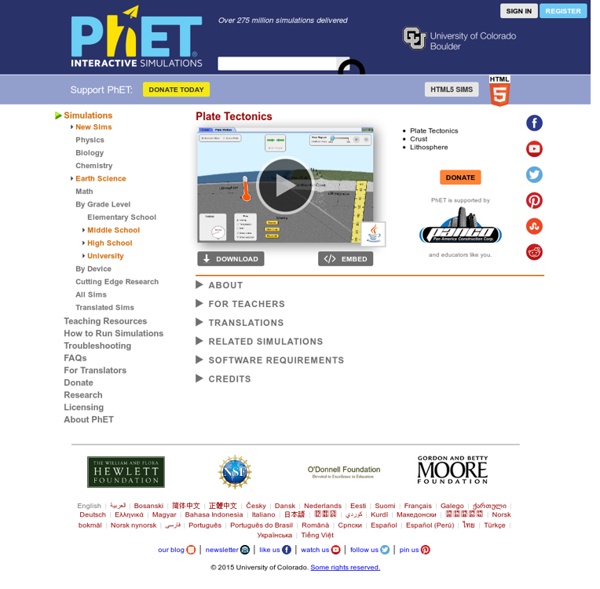Plate Tectonics - Crust, Lithosphere, Mantle
Topics Plate Tectonics Crust Lithosphere Mantle Density Buoyancy Earth Science Description Explore how plates move on the surface of the earth. Change temperature, composition, and thickness of plates. Discover how to create new mountains, volcanoes, or oceans! Sample Learning Goals Describe the differences between oceanic and continental crust, including their respective properties of density, composition, temperature and thickness.Predict how changes in composition and temperature change crust density and buoyancy.Draw a time series for different types of plate boundaries and their motions, indicating the related surface features.Deduce the type of plate boundary given images or descriptions of surface features.Explain which types of plate boundaries create crust, and which destroy crust Version 1.02
Frostbite Theater
Welcome to Frostbite Theater, a collection of science videos produced by Jefferson Lab! Liquid Nitrogen Experiments Have you ever wanted to play with liquid nitrogen, but didn't happen to have any lying around the house? Liquid Oxygen vs. Liquid nitrogen not exciting enough for you? Static Electricity Experiments We hope you'll get a charge out of these shocking experiments! The Half-life of Barium-137m Have you ever wanted to do an experiment using radioactive materials but didn't happen to have your own supply of sources, scintillators and photomultiplier tubes? Experiments You Can Try at Home! Do you want to do some experiments yourself, but don't happen to have a Van de Graaff generator or your own personal supply of liquid nitrogen? March Microscope Madness! Join us every Monday in March for March Microscope Madness! Monarch Butterflies Simply an amazing creature! Astronomy Just for Fun Not everything in science has to be an experiment, you know.
For Kids & Teachers | Bill Nye the Science Guy
Hey kids, hey teachers! Here are the Home Demos, the experiments you should try at home sometime. We call them demonstrations (demos for short), because we hope we already know what’s going to happen. Keep clicking around and you’ll find the Episode Guides. We’ve also made it easy for anyone to select from a number of Printable One Sheets. My latest project is about math. Challenge yourself.
Europa’s ocean: Evidence of Jupiter’s moon ocean found on the surface.
Image credit: NASA/JPL-Caltech He killed Pluto, but he may have just breathed life into Europa exploration. Astronomer Mike Brown*—discoverer of the giant outer-solar-system iceball Eris which is what started the machinery that kicked Pluto out of the planet club—has found some pretty strong evidence that Jupiter’s moon Europa has sprung a leak. Its undersurface ocean may be mixing with the icy surface, making it possible to understand its composition without having to dig down through dozens of kilometers of solid ice. Mind you, we’ve been eyeballing Europa’s ocean as a potential habitat for life for decades. This evidence that the surface ice and undersurface ocean are in intimate contact comes in a series of steps, which I outline below. Image credit: NASA/JPL/Galileo The water is kept liquid by heating via tidal forces, the effects of the gravity of its massive parent planet. The new data taken by Brown and his colleague Kevin Hand indicate that ocean is much like Earth’s: salty.
Molecular Workbench
Three Views of MW Senior Scientist and Molecular Workbench Developer Charles Xie, Researcher and Manager Amy Pallant, and Technology and Curriculum Developer Dan Damelin describe the history of Molecular Workbench and our vision for the future. Watch the Video undefinedundefinedundefined Selected Curriculum Modules Transistor Semiconductor Plasma Molecular Rover Chemical Bonding Chemical Resp. Diffusion Heat & Temperature Electrostatics Phase Change DNA to Protein Mission: Immunity Lipids & Carbs Tree of Life Proteins & DNA Harvest Light Quantum Mechanics Crystallography More Modules » Launches MW Create Your Own Simulations MW is not just a collection of simulations—do not be deceived by first glance. Learn More in MW's Online Manual » Launches MW Create Your Own Curriculum Modules A simulation without instructional support is difficult for students to use. Learn More in MW's Online Manual » Launches MW Fun Stuff Electrostatic Maze 3D Maze Roving Nanogear Block Feeder Probability Machine Dainty Walker Water Wheels
MA weather
The Mayan Calendar - an explanation
Cyclical: One of the wheels in the Mayan Calendar ©iStockphoto.com/Xixun Count down to the end of the Mayan calendar using our Mayan Calendar Countdown. The Mayan calendar moves in cycles with the last cycle ending in December 2012. Count down the seconds to “the end” The best doomsday prophecies in history The last day of the Mayan calendar corresponds with the Winter Solstice (or December Solstice), which has played a significant role in many cultures all over the world. The Maya didn't invent the calendar, it was used by most cultures in pre-Columbian Central America – including the Maya – from around 2000 BC to the 16th century. Wheels working together The Mayan Calendar consists of three separate corresponding calendars, the Long Count, the Tzolkin (divine calendar) and the Haab (civil calendar). The three calendars are used simultaneously. The Haab The Haab is a 365 day solar calendar which is divided into 18 months of 20 days each and one month which is only 5 days long (Uayeb).
potassium
Weather - Interactive
New Englanders have a saying: "If you don't like the weather, just wait a minute." Weather forecasts may be more stable in other parts of the world, but the basic idea stands. Weather is dynamic, the product of interacting forces we are only beginning to understand. Witness the weather extremes caused by El Niño in 1997 and 1998. El Niño raised water temperatures in the Pacific and the effects were felt worldwide: crop failures, disease outbreaks, excess snow, or too little rain. Weather may change on a daily basis, but climate changes over geologic time. Join us as we explore the forces behind the weather.
Related:
Related:



